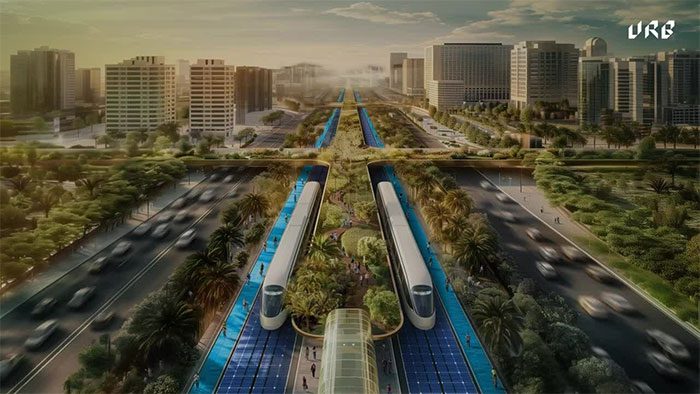The Green Spine Highway stretches 64 km, plants over 1 million trees, and can generate 300 MW of solar power, sufficient to supply approximately 130,000 homes.
The sustainable architecture firm from Dubai, URB, will construct the world’s “greenest” highway in this city, as reported by Design Boom on July 10. The new project is named Green Spine and aligns with the Dubai Urban Master Plan 2040—a long-term strategy aimed at shaping Dubai’s sustainable development over the next two decades.
The construction project of the Green Spine Highway in Dubai. (Video: URB)
The Green Spine Highway will be 64 km long, repurposing the old Sheikh Mohammad Bin Zayed Road (E311). The project aims to promote non-motorized transport and reduce carbon emissions around the city. Nearly 8 million residents could benefit from this initiative.
The Green Spine will utilize 100% renewable energy, primarily solar energy. Electric trains moving along the highway will run on tracks integrated with solar panels, drawing energy directly from them. This technology eliminates the need for overhead power lines.
The project aims to produce 300 MW of clean solar energy, enough to power around 130,000 homes in Dubai. Transitioning from fossil fuels to this clean energy source is expected to significantly reduce the city’s carbon emissions, estimated at about 1,051,200 tons per year.
Over one million trees will be planted along the highway to enhance biodiversity. Greenery will surround walkways for pedestrians and cyclists. Residents will be able to walk among the rows of trees and even grow vegetables in vertical farms along the highway. “These structures are designed to improve air quality, reduce urban heat, and provide residents and visitors with an accessible, safe, and enjoyable route for commuting and relaxing, thereby enhancing the overall quality of urban life,” URB stated.

Over one million trees will be planted along the highway to enhance biodiversity.
The Green Spine employs advanced technology for efficient resource management. A sensor system will monitor traffic and energy usage in buildings and other infrastructure, allowing for real-time adjustments. Additionally, a smart drainage system with porous surfaces will be installed to prevent flooding. The highway will also feature bioswales to manage rainwater runoff.
The Green Spine will also include educational programs, amenities, and recreational spaces. The project is expected to stimulate economic opportunities and social connectivity. However, the project is still in the conceptual stage, and the development process may take several years. URB has not disclosed the estimated costs or a timeline for development.


















































